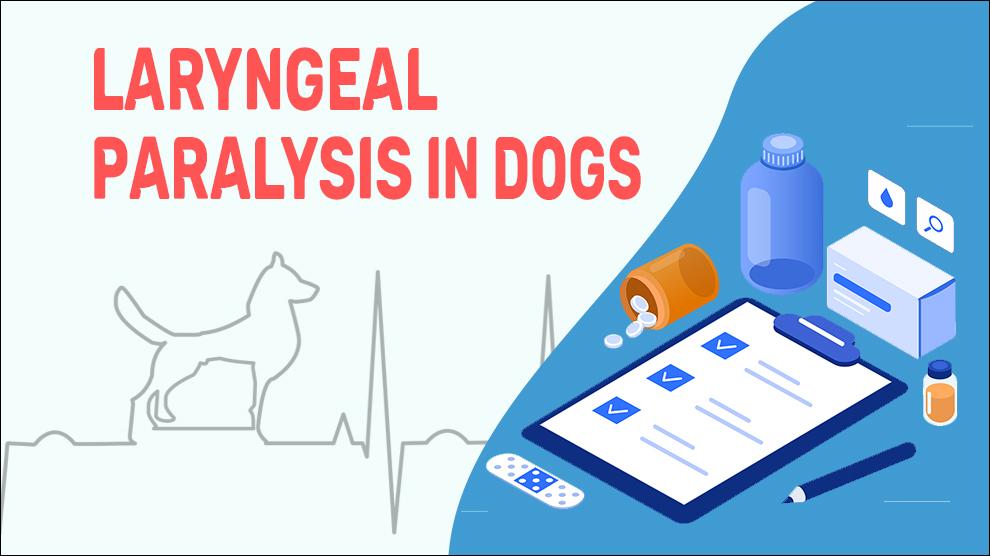What Is Laryngeal Paralysis In Dogs?
Laryngeal paralysis (LP), also known as "lar par" for short, is of fairly simple disease to understand. The condition interferes with normal breathing and can cause significant anxiety, respiratory distress as well as serious medical concerns for affected pets.
The vastly under-appreciated organ larynx is the guardian of the airways, closes the respiratory tract off whenever we want to swallow food, and directs air in if we need to take a deep breath.
The stability of the larynx is maintained by the arytenoid cartilage on one or both sides of the larynx. When the nerves of these muscles become paralyzed or weak (paretic), the muscles become flaccid and flop into the airway resulting in laryngeal paralysis.
The most common form of idiopathic LP is usually seen in older, large breed dogs and has a clinical manifestation of neuromuscular disease. A new term was recently referred to describe this- geriatric onset laryngeal paralysis polyneuropathy (GOLPP) – earlier known as ‘generalized peripheral polyneuropathy’
Symptoms Of Laryngeal Paralysis In Dogs
- Coughing or gagging when eating or drinking
- Dark red or purple-colored tongue
- Respiratory gasping or distress
- Abnormal- bark sound (dysphonia), as if the pet has laryngitis
- Exercise intolerance
- Excess panting
- Voice change
- Fatigue
Treatment Options For Laryngeal Paralysis In Dogs
The diagnosis of lar par is rather easy and customized to your dog's needs, there are great treatment options available.
For mildly affected dogs - Conservative therapy is enough. Lifestyle changes like avoiding strenuous exercise and extremely warm conditions may be enough.
For overweight or obese dogs: Maintaining a healthy weight will be very important.
Anti-inflammatory medication to reduce swelling and inflammation of the larynx are often beneficial as well.
Arytenoid lateralization: Dogs having severe difficulty in breathing are often considered great candidates for surgery. Though there are several techniques, lateralization of the arytenoid cartilage of the larynx (laryngeal tie back) is the surgery of choice for most vets.
The surgery involves permanent "tie-back" one or both sides of the larynx into a securely open position. This reduces upper airway obstruction and the nerves that cannot open the larynx can be effectively balanced. The related clinical signs such as the larynx aren’t able to open and close efficiently are also relieved through the tieback procedure. The drawback of this surgery is, that it exposes the larynx (as it is always open) and increases the danger of pneumonia.
Tracheotomy: Rarely this surgery is performed for the candidates that are not suitable for ‘arytenoid lateralization’. The trachea is surgically opened and a permanent tube is inserted to keep open the damaged structures.
Home Remedies For Laryngeal Paralysis In Dogs
Laryngeal paralysis is a degenerative and progressive condition, so surgical intervention is the best option.
Check with your vet for post surgical home health care.
Prevention Of Laryngeal Paralysis In Dogs
Laryngeal paralysis due to the hereditary abnormality can be prevented by stopping the breeding of affected dogs so that the risk of passing the condition on to the next generation is averted.
For idiopathic causes, nobody so far knows how to completely prevent it. When you go to a breeder for a new dog or get a dog with an unknown background, ask to screen for hereditary medical conditions or do a health check prior to getting the dog—
Prevent obesity in your dog and commit to maintaining a healthy weight.
Affected Dog Breeds Of Laryngeal Paralysis
Bouvier Des Flandres, Bull Terrier, Dalmatian, Rottweiler, Siberian Husky, Labrador Retriever, Golden Retriever, Saint Bernard, Irish Setter
Additional Facts For Laryngeal Paralysis In Dogs
Causes:
- Congenital - congenital polyneuropathy or hereditary laryngeal paralysis
- Acquired -
- Traumatic
- Neurological
- Neoplasia
- Polyneuropathy
- endocrinopathy
Morbidity:
Some breeds are prone to congenital laryngeal paralysis, while large breed dogs that develop in old age are said to have acquired laryngeal paralysis.
One of the main reasons the Laryngeal paralysis is under-diagnosed is the signs are typically mild at first until the condition progresses, and at an advanced stage, the pet has more obvious breathing difficulties.
In warm temperatures, affected dogs are more prone to overheating and overexertion.As they cannot efficiently use panting to cool themselves, the chances of developing severe respiratory distress are high.
Diagnosis:
- Examination of the larynx using an endoscope
- Chest radiographs
- Complete blood testing including thyroid tests
Mortality:
LP surgery has been associated with a 14 % postoperative mortality rate. However, surgical corrections of dogs reach a median survival time of 3-5 years.
Prognosis:
The aetiology determines the prognosis after surgical correction
Traumatic causes usually have a good prognosis, whereas polyneuropathy or tumor-induced LP has a guarded prognosis.
The slowly progressive disease acquired idiopathic LP also has a good prognosis.
When To See A Vet For Laryngeal Paralysis In Dogs?
Contact your vet right away, if you notice any of the following:
- Respiratory gasping or distress
- Excess panting
- Abnormal- bark sound (dysphonia)
Food Suggestions For Laryngeal Paralysis In Dogs
- Fresh, lean protein (Lean ground beef, White-meat skinless chicken or turkey)
- Antioxidants- Blueberries, blackberries, Steamed broccoli, spinach, cooked yellow squash, kale, and green beans.
- Low-carb dog food/peas, sweet potatoes, squash, yams, pumpkin, etc.
- Iron: lean meats like ground beef and lamb, fish, such as sardines and salmon, pumpkin, carrots, and leafy greens.
- vitamin C and bioflavonoids: Brussel sprouts, spinach, broccoli, kale, pineapple, papaya, strawberries, etc
Conclusion
The prognosis is excellent when it is diagnosed early. Typically, the dog's quality of life is improved by the surgery.
After surgery, the main obstacle to watch out for is the possibility of adverse pulmonary consequences due to aspiration pneumonia. However, the risk can be managed by the awareness of the signs and following your vet's recommendations.

















